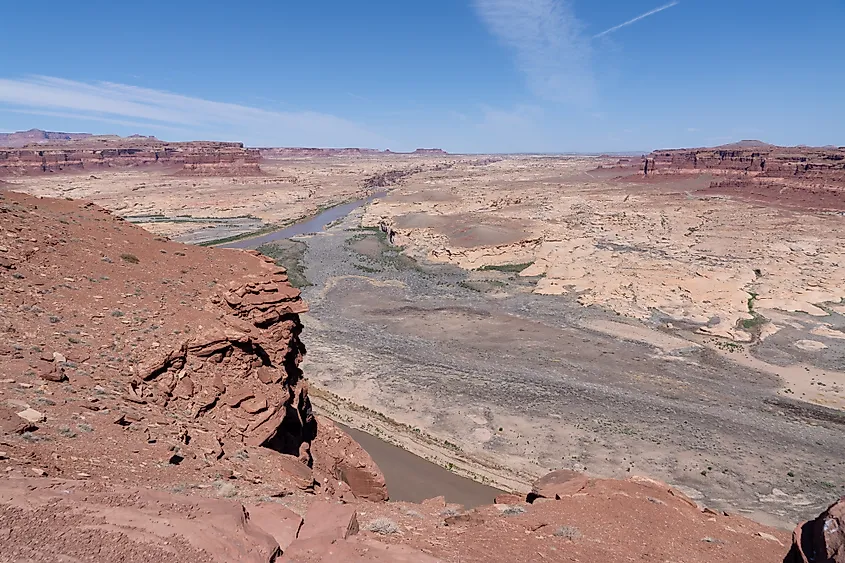Imagine a future where the iconic Colorado River, responsible for supporting millions of people and ecosystems, shrinks to a mere trickle. A future where the majestic canyons carved by its waters stand parched and barren, a stark reminder of a lost era. While this grim picture might seem like a dystopian novel, it is a reality that we are rapidly approaching, a stark warning of the consequences of our unsustainable use of water resources.

Image: www.worldatlas.com
The Colorado River, a lifeblood of the American West, is facing an unprecedented crisis. Decades of over-allocation, exacerbated by climate change and drought, have taken a heavy toll on the river’s flow, threatening its very existence. As the flow continues to dwindle, the region faces a water shortage of epic proportions, with dire consequences for cities, agriculture, and the delicate ecosystems that depend on the river.
A River Under Pressure: The History of Over-Allocation
The story of the Colorado River’s decline begins with a century of ambitious development projects. In 1922, the Colorado River Compact was signed, dividing the river’s water among seven states: Colorado, Utah, Wyoming, New Mexico, Arizona, Nevada, and California. At the time, this seemed like a pragmatic solution to manage water resources in a rapidly growing region. However, the compact was based on an era of abundant water. What was not considered was the impact of climate change, population growth, and increasing water demands.
The Colorado River Compact was forged during a period of unprecedented wet conditions, leading to an overestimation of the river’s flow. This overestimation, combined with the constant expansion of water infrastructure, such as dams and reservoirs, resulted in a system that was inherently unsustainable. The river was tasked with providing water to a vast network of cities, farms, and industries, far exceeding its natural capacity.
Climate Change: A Wrench in the Works
If the Colorado River’s future was already uncertain due to over-allocation, climate change added another layer of complexity. The American West is experiencing a prolonged megadrought, the driest period in the region in at least 1,200 years. This drought, intensified by rising temperatures and shifts in weather patterns, has significantly reduced the amount of snowfall in the Rocky Mountains, the source of the river’s water. The snowpack, which acts as a natural reservoir, is shrinking, leading to a decline in river flow.
Climate change is not only reducing the amount of water flowing into the Colorado River but also exacerbating existing problems. Higher temperatures increase evaporation rates, further reducing the amount of water available. This vicious cycle is driving the Colorado River towards a point of no return, where its flow might not be enough to sustain even the most basic needs.
The Dwindling River: Consequences for Cities, Agriculture, and Ecosystems
The shrinking of the Colorado River has far-reaching consequences, threatening the livelihoods of millions of people. Cities like Los Angeles, San Diego, and Phoenix depend heavily on the river for drinking water. Agriculture, a vital industry in the region, also relies on the Colorado River for irrigation. The Central Arizona Project (CAP), a massive canal system, delivers water from the Colorado River to farms and cities in Arizona, demonstrating the river’s critical role in sustaining the region’s economy.
Beyond human needs, the Colorado River is vital to the health of ecosystems throughout the American West. The river supports diverse wildlife, including fish like the endangered humpback chub and the endangered Colorado pikeminnow. The river’s flow sustains forests, wetlands, and riparian areas, providing critical habitat for a wide range of species. The drying up of the Colorado River would not only deprive millions of people of water but also destroy a unique and invaluable natural resource.

Image: abcnews.go.com
Looking Ahead: A Path Towards Sustainability
The future of the Colorado River is a cause for concern, but it is not a foregone conclusion. There is a growing awareness of the need to conserve water and transition to more sustainable practices. Efforts are underway to improve water efficiency, reduce water waste, and implement water conservation measures across the region.
The focus is shifting from simply managing water to conserving it. This includes improving irrigation methods, upgrading aging infrastructure, and adopting innovative solutions like rainwater harvesting and greywater recycling. The goal is to reduce demand and restore the river’s natural flow.
While these efforts are promising, more needs to be done to address the root causes of the crisis. This includes tackling climate change through reducing greenhouse gas emissions and investing in renewable energy. These actions are crucial to mitigating the impact of climate change on the Colorado River and ensuring the long-term sustainability of water resources in the American West.
When Will The Colorado River Dry Up
A Call To Action: Our Future Depends On It
The future of the Colorado River is not solely in the hands of policymakers and water managers. Each of us has a role to play in ensuring the river’s survival. We can all make conscious efforts to conserve water in our daily lives. From taking shorter showers to watering lawns efficiently, even small actions can have a collective impact on water consumption.
The Colorado River is a symbol of the West, a reminder of its beauty and resilience. Its drying up would be a tragedy, not just for the region, but for the entire world. Let us work together to protect this vital resource, safeguarding its future for generations to come. The time to act is now.



/GettyImages-173599369-58ad68f83df78c345b829dfc.jpg?w=740&resize=740,414&ssl=1)


